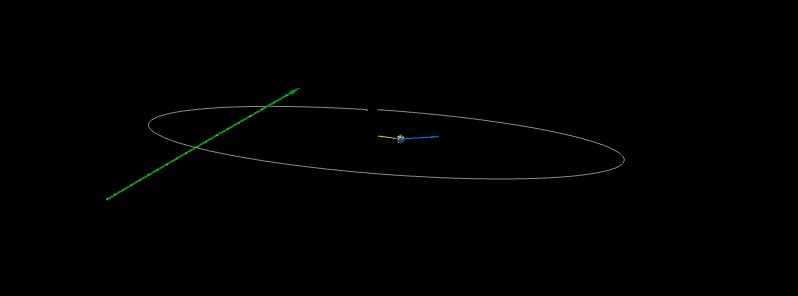Asteroid 2017 UR2 flew past Earth at 0.83 LD, 2 days after discovery

A newly discovered asteroid designated 2017 UR2 flew past Earth at 0.83 LD / 0.00213 AU (~318 643 km / 197 995 miles) on October 17, 2017, two days after it was discovered. This is the 43rd known asteroid to flyby Earth within 1 lunar distance since the start of the year, 8th this month, and 7th in the past 10 days.
2017 UR2 belongs to the Apollo group of asteroids. Its estimated diameter is between 7.5 and 17 m (24 – 55 feet) and it flew past Earth at a speed (relative to the Earth) of 10.84 km/s at 16:32 UTC on October 17.
It was first observed at ATLAS-MLO, Mauna Loa on October 19, 2017, two days after its flyby.
[ Ephemeris | Orbit Diagram | Orbital Elements | Physical Parameters | Close-Approach Data ]
Its flyby happened three days before very close flyby of 2017 UJ2, the second closest this year. UJ2 flew past us at 0.05 LD or 0.00012 AU (~17 951 km / 11 154 miles) from the center of Earth on October 20, 2017, one day before it was discovered.
The only known asteroid to flyby us closer than 2017 UJ2 this year is 2017 GM. This one flew past at 0.04 LD / 0.00011 AU (~16 455 km / 10 225 miles) from the center of Earth on April 4, 2017.
2017 UR2 is also the 8th known asteroid to flyby Earth within 1 lunar distance this month and the 7th in the past 10 days.
The only month this year that had more flybys within 1 LD than October was March (with 9). The only month with no known flybys this year was June, followed by July with 1.
October, however, is the only month this year with 7 such flybys within 10 days, followed by March with 6 flybys within 10 days. Interestingly, those 6 flybys in March all happened within 3 days, from the 17th to 20th.
If we look at per day statistics, March 20 and September 20 are the leaders, with 3 known flybys, followed by March 17, May 4, and September 24 with 2 known flybys.
As of October 21, there are 16 992 known near-Earth objects, 16 886 of them are asteroids. Of all known asteroids, 884 have diameters roughly 1 km (0.62 miles) or larger, while 7 864 have diameters roughly 140 m (460 feet) and larger.
Since the start of the year, scientists have discovered 1 480 near-Earth objects, all of them are asteroids. 43 of them flew past Earth within 1 lunar distance, including 2017 UR2.
Reference:
Asteroid 2017 UR2 at Minor Planet Center; CNEOS
Featured image: The green line indicates the object's apparent motion relative to the Earth, and the bright green marks are the object's location at approximately one-hour intervals. The Moon's orbit is grey. The blue arrow points in the direction of Earth's motion and the yellow arrow points toward the Sun. Credit: Minor Planet Center

Commenting rules and guidelines
We value the thoughts and opinions of our readers and welcome healthy discussions on our website. In order to maintain a respectful and positive community, we ask that all commenters follow these rules:
We reserve the right to remove any comments that violate these rules. By commenting on our website, you agree to abide by these guidelines. Thank you for helping to create a positive and welcoming environment for all.